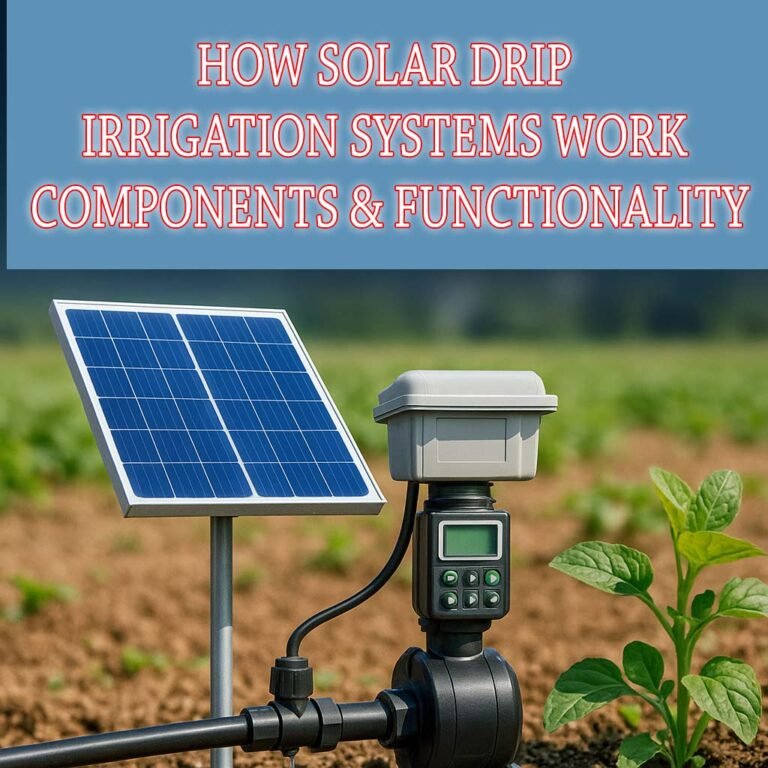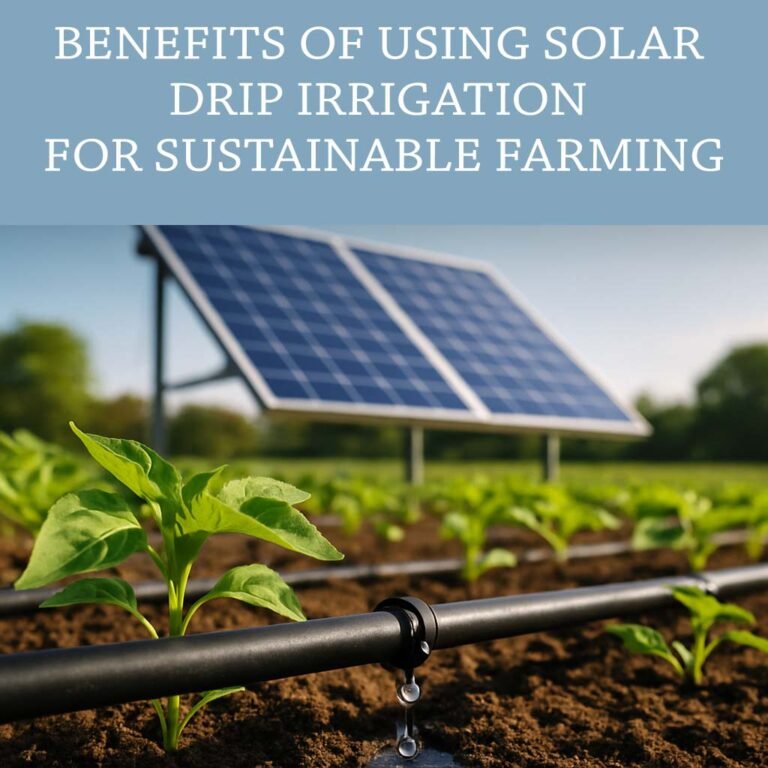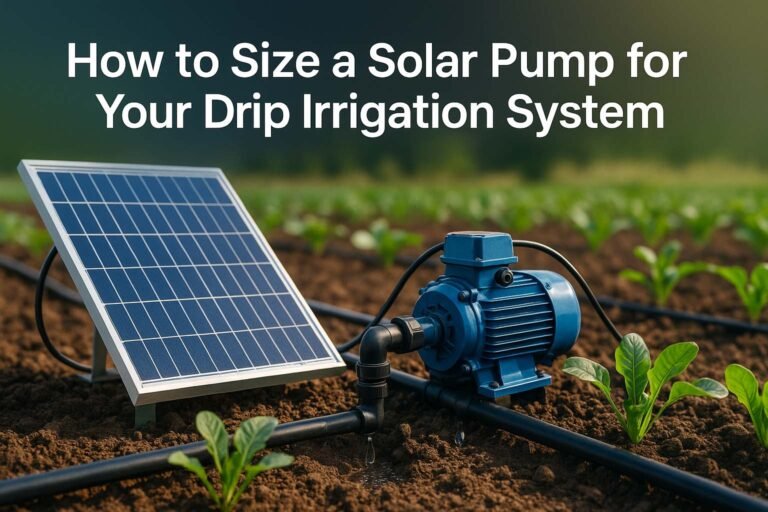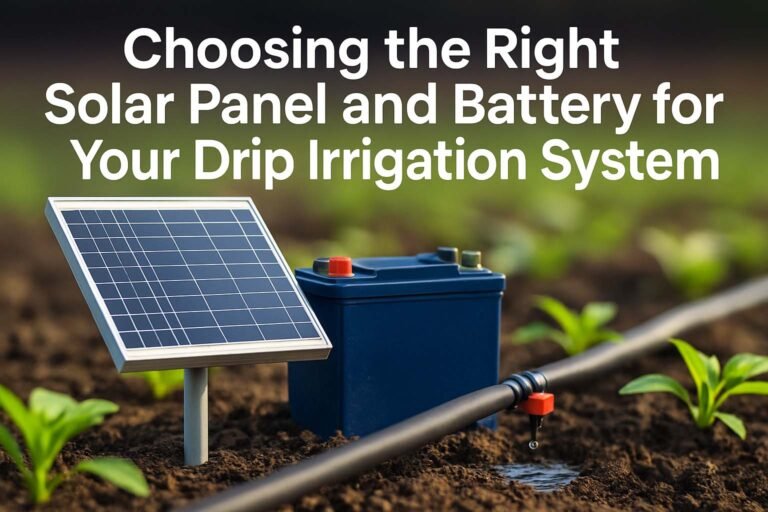Key Components of a Solar-Powered Drip Irrigation System
A solar-powered drip irrigation system is a modern agricultural solution that combines solar energy with precision irrigation. It brings together sustainability, efficiency, and technology to help farmers irrigate crops without relying on grid electricity or diesel pumps. In regions with high sunlight and water scarcity, this system plays a vital role in improving crop yield while conserving water and energy.

This article explores the key components that make up a solar-powered drip irrigation system. We’ll dive into the technical aspects, explain how each part functions, and show you why this system is a smart investment for agriculture today.
Understanding the Solar-Powered Drip Irrigation System
A solar-powered drip irrigation system uses solar energy to power a water pump. This pump draws water from a source like a well or tank and supplies it to crops through a network of drip lines. The water is delivered drop by drop at the root level, ensuring minimum wastage and maximum absorption.
The entire setup is eco-friendly, cost-effective, and efficient. It works best in off-grid farms, remote villages, and areas with ample sunlight.
Learn more about DIY solar drip irrigation system.
Core Benefits of a Solar-Powered Drip Irrigation System
Before exploring the components, let’s look at why this system is gaining popularity:
- Saves water by delivering it directly to the roots
- Runs on solar power, reducing electricity bills
- Low operational cost after installation
- Scalable to suit small or large farms
- Improves crop yield and plant health
Now let’s break down the technical components that make it all work.
Solar Panels – The Energy Source
At the heart of every solar-powered drip irrigation system are solar photovoltaic (PV) panels. These panels convert sunlight into electricity.
Use our free online solar power load calculator to confirm load calculation for solar system.
How They Work
When sunlight hits the solar cells, it generates direct current (DC). This DC electricity is then used to run the DC water pump or converted into alternating current (AC) for AC pumps.
Technical Specifications
| Parameter | Typical Range |
|---|---|
| Power Output | 200W – 5000W |
| Voltage | 12V / 24V / 48V |
| Panel Type | Monocrystalline or Polycrystalline |
| Mounting Type | Fixed Tilt or Adjustable Tilt |
Panels should be oriented to maximize sun exposure. Dust and shade must be avoided to keep the system efficient.
Learn more about Difference Between AC Submersible Pump and DC Submersible Pump
Solar Pump – The Workhorse
The solar water pump is responsible for drawing water from the source and supplying it to the drip system.
Types of Pumps
- DC Surface Pumps – Suitable for shallow water sources
- DC Submersible Pumps – Ideal for deep bore wells
- AC Pumps with Inverters – Used in larger systems
Key Specifications
| Feature | Surface Pump | Submersible Pump |
|---|---|---|
| Depth Range | Up to 7m | 10m to 200m |
| Flow Rate | 20 LPM – 2000 LPH | 1000 LPH – 20,000 LPH |
| Power Requirement | 250W – 3000W | 500W – 5000W |
Pump selection depends on the depth of the water source and irrigation needs.
Inverter and Charge Controller
If the pump is AC, an inverter is needed to convert DC from the panels into AC. A solar charge controller is used in battery-supported systems to regulate voltage and prevent overcharging.
Battery Integration
In places with inconsistent sunlight, batteries store excess solar energy to ensure uninterrupted irrigation. While optional, batteries add reliability.
| Component | Role |
|---|---|
| Inverter | DC to AC Conversion |
| Charge Controller | Manages battery health |
| Battery Bank | Stores solar power |
Use MPPT (Maximum Power Point Tracking) controllers for higher efficiency.
Drip Irrigation Network
This is the final stage of the system, where water is delivered to plants.
Key Parts
- Mainline Pipe – Carries water from the pump to the field
- Sub-main and Laterals – Distribute water to specific zones
- Drippers/Emitters – Release water in controlled quantities
Dripper Flow Rates
| Crop Type | Dripper Flow Rate (L/hr) |
|---|---|
| Vegetables | 2 – 4 |
| Orchards | 4 – 8 |
| Flowers | 1 – 2 |
| Row Crops | 2 – 3 |
Spacing and flow rate depend on crop type and soil condition. Proper design ensures uniform water distribution.
Water Filtration Unit
Clean water is essential in a solar-powered drip irrigation system to prevent clogging.
Common Filters
- Screen Filters – Remove large particles
- Sand Filters – Trap fine sediments
- Disc Filters – Handle organic materials
The type of filter depends on water source quality. Filters must be cleaned regularly.
Water Storage and Source
The system needs a reliable water source—either a well, borehole, pond, or tank. Sometimes, a storage tank is used to stabilize flow.
Water Source Options
- Underground Borewell
- Rainwater Harvesting Tank
- Open Wells or Ponds
Storage tanks should be elevated to maintain gravity pressure if needed.
Automation and Monitoring Systems
Modern systems may include automation features for ease of use.
Features to Consider
- Timers – Schedule irrigation automatically
- Moisture Sensors – Monitor soil moisture
- Flow Meters – Track water usage
- Mobile App Integration – Remote control and alerts
Automation reduces labor and ensures precision irrigation.
Installation Considerations
While setting up a solar-powered drip irrigation system, attention must be given to:
- Site survey for solar exposure
- Water demand analysis
- Crop layout and irrigation schedule
- System sizing (solar panel capacity, pump rating)
Professional installation ensures reliability and safety.
Cost Overview
Here’s a cost estimate for a small-to-medium scale system:
| Component | Estimated Cost (USD) |
|---|---|
| Solar Panels (1kW) | $600 – $900 |
| Solar Pump (1HP) | $500 – $800 |
| Drip Kit for 1 Acre | $300 – $500 |
| Inverter and Controller | $200 – $400 |
| Installation & Wiring | $300 – $600 |
| Total Estimated Cost | $1900 – $3200 |
Prices vary based on region, quality, and brand.
Maintenance of a Solar-Powered Drip Irrigation System
Routine checks and maintenance help extend the life of the system.
- Clean solar panels every few weeks
- Inspect filters and clean them regularly
- Flush drip lines to avoid clogging
- Check connections for leaks or damage
Most systems are low-maintenance but should be inspected seasonally.
Applications and Use Cases
The system is perfect for:
- Vegetable farms
- Orchards
- Greenhouses
- Remote and off-grid farms
- Water-scarce regions
It supports sustainable agriculture, climate-smart farming, and promotes renewable energy adoption in rural areas.
Final Thoughts
A solar-powered drip irrigation system is a practical solution for sustainable farming. By integrating renewable energy with efficient water use, it empowers farmers to grow more with less. Understanding the components of this system helps in planning, designing, and maintaining it effectively.
Follow Us on Social:
Subscribe our Newsletter on Electrical Insights to get the latest updates in Electrical Engineering.
#SolarIrrigation, #DripIrrigationSystem, #SolarPoweredFarming, #SustainableAgriculture, #SolarWaterPump, #RenewableEnergy, #SmartFarming, #WaterConservation, #GreenEnergy, #OffGridIrrigation, #SolarDripSystem, #SolarFarmingTech, #EcoFriendlyFarming, #AgritechSolutions, #CleanEnergyForFarms






